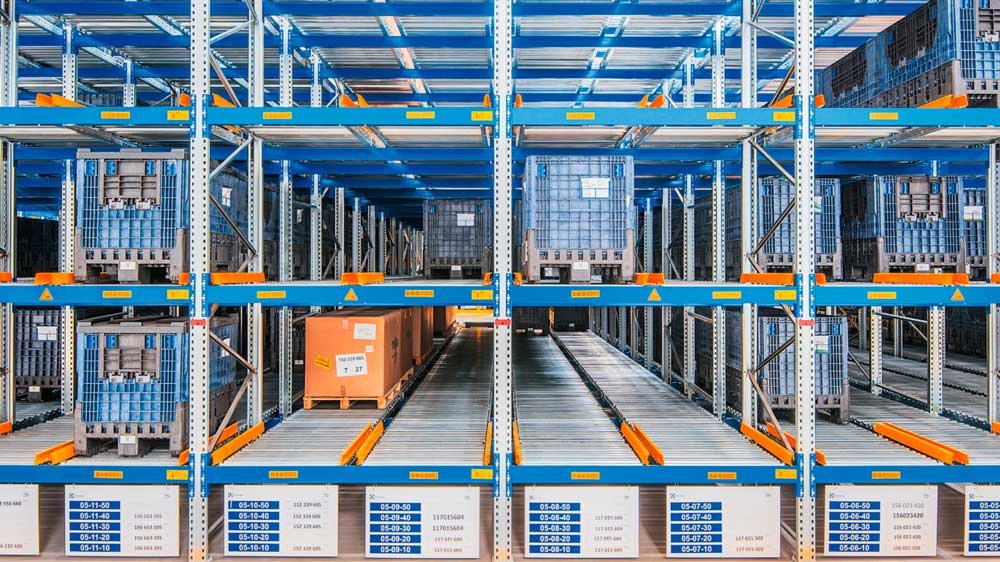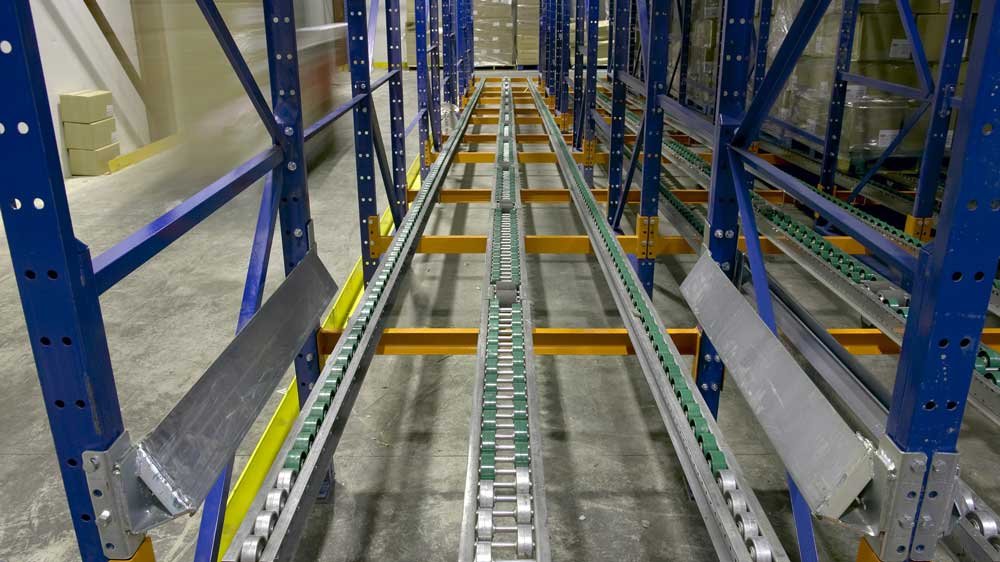Gravity flow racking is not the most common type of warehouse racking system that we see, but if your work or life often comes into contact with places like warehouses, then you probably have some impression of it.
So, if you are in need of a systematic study of gravity flow racking, then we are glad that you have come to the right place! Let us answer everything you need to know about gravity flow racking!
What is gravity flow racking?
Gravity flow racking is a type of industrial racking for warehouses that is characterized by the use of gravity to allow the goods in the rack to achieve the ability to slide.
Why can I realize the sliding? Because gravity flow racking not only relies on the role of gravity, they are also designed into a certain angle of inclination of the racking channel and the channel sets up wheels or rollers, so that when the goods go into which, it will be able to realize the sliding.

In a real-life scenario, goods are placed in the deposit area (usually on the higher side) and then automatically slide from the deposit area to the take-out area (usually on the lower side). After that, the goods will be placed in the order of access, and the first to be deposited will be the first to be removed, which is also the way of inventory management in FIFO.

What are the advantages of gravity flow racking?
Reduced Aisle Occupancy
Because gravity flow racking is different from traditional racking in that goods are deposited on one side and removed on the other. Therefore, it does not require special access/forklift aisles between each set of racks in the actual use scenario. In this way, the storage density can be increased and the warehouse space can be utilized more efficiently.
FIFO Inventory Management
For some goods with strict shelf life and inventory period, FIFO inventory management method is very suitable for this kind of goods. Because the first goods you put in, will be the first to be taken out.
Improved Access Efficiency
Gravity flow racking only requires the staff to place the goods in the deposit area, then the goods will automatically slide in the racking channel, and finally the staff will take out the goods in the take-out area.
As the first piece of goods is taken out, the second piece of goods will automatically slide to the position where it has just been taken out, and so on until all the goods in the aisle have been taken out and no new goods are added.
This access method saves the staff’s time to move the goods, the staff’s work only needs to deposit and take out, so it also greatly improves the access efficiency.
Safety
Because of the special design of gravity flow racking, forklift trucks do not need to work in or between the racks, which can greatly reduce the risk of accidents caused by forklift trucks’ faulty operation.
Moreover, as long as the regular maintenance of the racking is ensured, the sliding process of the goods in the racking channel is very safe, which also reduces the probability of damage to the goods in human movement.
Types of gravity flow racks
There are many different types of gravity flow racking according to different needs. I will not go into details about some customized types, but I will mainly tell you some common types of gravity flow racking.
Carton Flow Racking
Carton flow racking has no significant design differences from gravity flow racking, the only major difference being the type of goods carried. Carton flow racking is mainly used in retail and e-commerce warehouses as the type of goods stored is basically small cardboard boxes.

Pallet Flow Racking
This type of gravity flow racking is characterized by the fact that it is specially designed to hold palletized goods, in short, for large/heavy goods, so the overall frame and sliding structure of the pallet flow racking is made of higher strength specifications.
Because of these characteristics, it is widely used in the food and beverage industry, which requires FIFO management of bulk commodities.

How do gravity flow racks work?
The working principle of gravity flow racking is very simple, next I will briefly introduce you to how it works.
The first step is to place our goods into the channel at the back end of the shelf (or the higher end).
The second step, the goods will be in the gravity and the role of the slide, automatically slide to the front end of the shelf (or lower end), this process we do not need to participate in, the goods are automatically slide processes.
The third step, when we need to take out the goods, is in the front of the shelf (or lower end) to take out the operation.
Fourth step, when we take out the goods, the next goods will be due to gravity and the reason for the slide automatically glides to the position where we have just taken out the goods. And so on, until the goods in this aisle have been removed and no new goods are added.
Application of gravity flow racks
Since there are many scenarios in which gravity flow racking can be used, I’ll give you some examples of common usage requirements and tell you which scenarios they correspond to.
FIFO Inventory Management
In industries where goods with strict shelf life are stored, the need for FIFO inventory management is paramount, and the gravity flow rack can fulfill this need.
This is why gravity flow racks are often found in the food and beverage industry.
Strict Batch Requirements
For example, pharmaceutical and chemical industries have strict batch management requirements, so each batch of goods produced should be arranged in order to facilitate tracking and recording.
The gravity flow rack FIFO inventory management method can be sorted according to the order of first-come-first-served, which is very suitable for this type of industry.
Picking Efficiency
Retail and e-commerce companies have high demands on picking efficiency. This is because the goods in these industries are mostly packaged in cardboard boxes and their dimensions are small, and because the goods are accessed frequently on a daily basis. So all these factors point to one answer: the gravity flow rack.
Conclusion
At the end of the day, I think you will have a general understanding of gravity flow racking, but if you have more questions about gravity flow racking, or if you don’t have a suitable supplier in your local area, or perhaps haven’t received a suitable quote, you are more than welcome to contact us!

